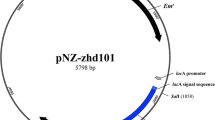Abstract
Zearalenone, a nonsteroidal estrogenic mycotoxin mainly produced by Fusarium species, causes reproductive disorders and hyperestrogenic syndromes in animals and humans. The bacterial strain Bacillus velezensis ANSB01E, isolated from chicken cecal content, was capable of effectively degrading zearalenone in both liquid medium and mouldy corn. Moreover, Bacillus velezensis ANSB01E exhibited good antimicrobial activities against animal pathogenic bacteria, including Escherichia coli, Staphylococcus aureus, and Salmonella spp. Genome-based analysis revealed the presence of genes coding peroxiredoxin and alpha/beta hydrolase in Bacillus velezensis ANSB01E, which may be involved in zearalenone degradation. The study on the genome provides insights into the zearalenone degradation mechanisms and advances the potential application of Bacillus velezensis ANSB01E in food and feed industry.





Similar content being viewed by others
References
Abbes S, Salah-Abbes JB, Ouanes Z, Houas Z, Othman O, Bacha H et al (2006) Preventive role of phyllosilicate clay on the immunological and biochemical toxicity of zearalenone in Balb/c mice. Int Immunopharmacol 6:1251–1258
El-Makawy A, Hassanane MS, Abd Alla E-SAM (2001) Genotoxic evaluation for the estrogenic mycotoxin zearalenone. Reprod Nutr Dev 41:79–89
Emidio ES, Calisto V, de Marchi MR, Esteves VI (2017) Photochemical transformation of zearalenone in aqueous solutions under simulated solar irradiation: kinetics and influence of water constituents. Chemosphere 169:146–154
Huang LC, Zheng N, Zheng BQ, Wen F, Cheng JB, Han RW et al (2014) Simultaneous determination of aflatoxin M1, ochratoxin A, zearalenone and alpha-zearalenol in milk by UHPLC-MS/MS. Food Chem 146:242–249
Holt JG, Krieg NR, Sneath PHA, Staley JT, Willams ST (1994) Bergey’s manual of determinative bacteriology, 9th edn. Williams and Wilkins, USA
Hsu TC, Yi PJ, Lee TY, Liu JR (2018) Probiotic characteristics and zearalenone-removal ability of a Bacillus licheniformis strain. PLoS ONE 13:e0194866
Iqbal SZ, Nisar S, Asi MR, Jinap S (2014) Natural incidence of aflatoxins, ochratoxin A and zearalenone in chicken meat and eggs. Food Control 43:98–103
Lei Y, Zhao L, Ma Q, Zhang J, Zhou T, Gao C et al (2014) Degradation of zearalenone in swine feed and feed ingredients by Bacillus subtilis ANSB01G. World Mycotoxin J 7(2):143–151
Ma R, Zhang L, Liu M, Su YT, Xie WM, Zhang NY et al (2018) Individual and combined occurrence of mycotoxins in feed ingredients and complete feeds in China. Toxins 10(3):113
Molinatto G, Puopolo G, Sonego P, Moretto M, Engelen K, Viti C et al (2016) Complete genome sequence of Bacillus amyloliquefaciens subsp. plantarum S499, a rhizobacterium that triggers plant defences and inhibits fungal phytopathogens. J Biotechnol 238:56–59
Rempe I, Kersten S, Valenta H, Danicke S (2013) Hydrothermal treatment of naturally contaminated maize in the presence of sodium metabisulfite, methylamine and calcium hydroxide; effects on the concentration of zearalenone and deoxynivalenol. Mycotoxin Res 29:169–175
Rodrigues I, Naehrer K (2012) A three-year survey on the worldwide occurrence of mycotoxins in feedstuffs and feed. Toxins 4:663–675
Steyn PS (1995) Mycotoxins, general view, chemistry and structure. Toxicol Lett 82:843–851
Takahashi-Ando N, Kimura M, Kakeya H, Osada H, Yamaguchi I (2002) A novel lactonohydrolase responsible for the detoxification of zearalenone: enzyme purification and gene cloning. Biochem J 365:1–6
Tinyiro SE, Wokadala C, Xu D, Yao W (2011) Adsorption and degradation of zearalenone by Bacillus strains. Folia Microbiol 56:321–327
Vekiru E, Fruhauf S, Hametner C, Schatzmayr G, Krska R, Moll WD et al (2016) Isolation and characterisation of enzymatic zearalenone hydrolysis reaction products. World Mycotoxin J 9:353–363
Vekiru E, Hametner C, Mitterbauer R, Rechthaler J, Adam G, Schatzmayr G et al (2010) Cleavage of zearalenone by Trichosporon mycotoxinivorans to a novel nonestrogenic metabolite. Appl Environ Microb 76:2353–2359
Wang G, Yu M, Dong F, Shi J, Xu J (2017) Esterase activity inspired selection and characterization of zearalenone degrading bacteria Bacillus pumilus ES-21. Food Control 77:57–64
Wang G, Xi Y, Lian C, Sun Z, Zheng S (2019) Simultaneous detoxification of polar aflatoxin B1 and weak polar zearalenone from simulated gastrointestinal tract by zwitterionic montmorillonites. J Hazard Mater 364:227–237
Wang N, Li P, Pan J, Wang M, Long M, Zang J et al (2018) Bacillus velezensis A2 fermentation exerts a protective effect on renal injury induced by zearalenone in mice. Sci Rep 8:13646
Xu J, Wang H, Zhu Z, Ji F, Yin X, Hong Q et al (2016) Isolation and characterization of Bacillus amyloliquefaciens ZDS-1: Exploring the degradation of zearalenone by Bacillus spp. Food Control 68:244–250
Xu Y, Wang Y, Ji J, Wu H, Pi F, Zhang Y et al (2019) Chemical and toxicological alterations of zearalenone under ozone treatment. Food Addit Contam A 36:163–174
Yu Y, Qiu L, Wu H, Tang Y, Yu Y, Li X et al (2011) Degradation of zearalenone by the extracellular extracts of Acinetobacter sp. SM04 liquid cultures. Biodegradation 22:613–622
Yu Y, Wu H, Tang Y, Qiu L (2012) Cloning, expression of a peroxiredoxin gene from Acinetobacter sp. SM04 and characterization of its recombinant protein for zearalenone detoxification. Microbiol Res 167:121–126
Zhang Y, Zhang Q, Feng X, Li S, Xia J, Xu H (2012) A novel agar diffusion assay for qualitative and quantitative estimation of ε-polylysine in fermentation broths and foods. Food Res Int 48:49–56
Zinedine A, Soriano JM, Molto JC, Manes J (2007) Review on the toxicity, occurrence, metabolism, detoxification, regulations and intake of zearalenone: an oestrogenic mycotoxin. Food Chem Toxicol 45:1–18
Acknowledgements
This work was supported by the grants from National Natural Science Foundation of China (Project No.31772637).
Author information
Authors and Affiliations
Corresponding author
Ethics declarations
Conflict of interest
The authors declare that they have no conflicts of interest.
Additional information
Publisher's Note
Springer Nature remains neutral with regard to jurisdictional claims in published maps and institutional affiliations.
Electronic supplementary material
Below is the link to the electronic supplementary material.
Rights and permissions
About this article
Cite this article
Guo, Y., Zhou, J., Tang, Y. et al. Characterization and Genome Analysis of a Zearalenone-Degrading Bacillus velezensis Strain ANSB01E. Curr Microbiol 77, 273–278 (2020). https://doi.org/10.1007/s00284-019-01811-8
Received:
Accepted:
Published:
Issue Date:
DOI: https://doi.org/10.1007/s00284-019-01811-8




